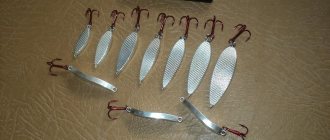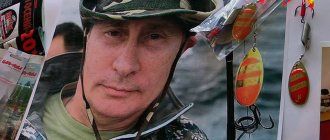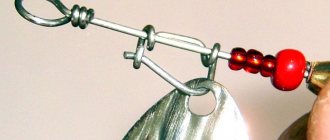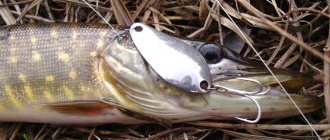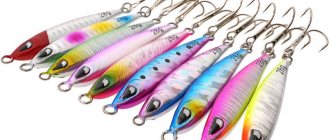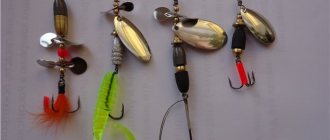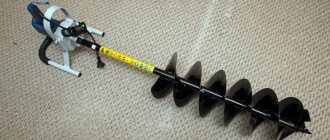Design Feature
Winter lure Ulyanka is designed for catching different types of fish. This bait can be installed on soft and frame types of fishing rods. The counterweight on the front allows you to cast gear up to 10 m.
When the part is immersed in water, it is not recommended to make sudden movements. This will allow the product to take the correct position inside the reservoir.
Ulyanka spinner: 120 photos, drawings, instructions and video master class on creating an effective spinner
The Ulyanka spinner got its name in honor of its developer Sergei Ulyanov. This type of fishing tackle is considered one of the best for catching rare species of fish.
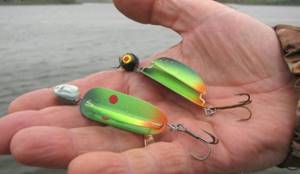
The design of this part consists of several plates that are connected to each other. When immersed in the water surface, they begin to actively move parallel to each other.
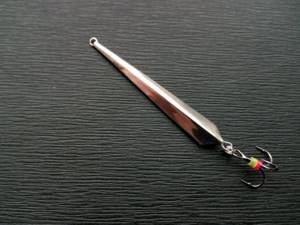
In the front part there is a counterweight in the form of a fish's head. At the back there is a metal tee made of sharp hooks. The vertical plate has an additional hole for fixing fishing line or cord.
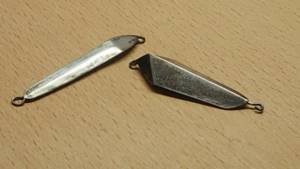
Brief contents of the review:
How to make an ulyanka spinner?
To create detailed fishing gear you will need the following types of parts. These include:
- A simple type of spinner with a movable base;
- Small plate element;
- Wire for fixing metal plates to each other;
- Several rings and hooks - tees.
Read here Do-it-yourself underwater camera for fishing - how to make a high-quality and reliable underwater camera (105 photos)
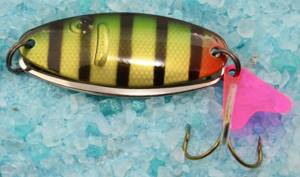
Experienced fishermen recommend sticking to the drawings for making a spinner bait. They will help you cope with some of the nuances in the manufacturing process of this part.

The size of the spinner bait should not exceed 6 cm. If the fishing tackle is larger than the recommended value, then the risk of diving to the very bottom of the reservoir increases. The weight of the product should not be more than 15 g.
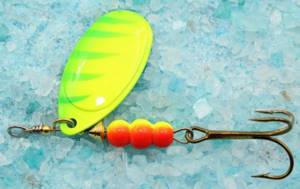
The main advantage of this gear is its gradual and smooth movement in the water column.
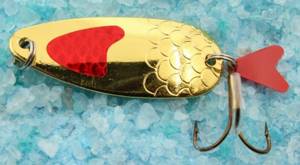
With gradual introduction, such a bait is capable of creating various vibrations. Sudden movements create high-frequency waves, which ensure rapid movement of metal plates.
Such behavior can interest large prey, which is located at the bottom of reservoirs.
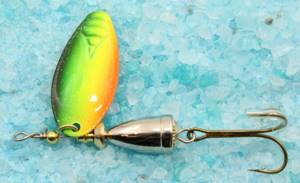
Do-it-yourself spinner Ulyanka
There are many options that allow you to make an ulyanka spinner with your own hands. Let's look at some of the simplest methods. For work, scrap materials are used.

Particularly popular are products made from the handle of a tablespoon. Thanks to this detail, it is possible to create an exact imitation of the asymmetry of the fish’s body. Finished products can be used for eyeliner in shallow water and in deep areas of the reservoir.
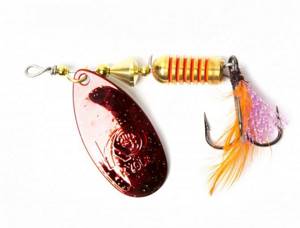
I present to your attention step-by-step instructions for creating a fishing accessory. It includes the following items:
- First of all, you need to saw off the spoon from the metal handle. Sand the sharp edge with fine abrasive sandpaper. The sawn-off handle must be shortened by 3 cm.
- Next, we make 2 through holes in the upper lower part. They will help secure the tee with hooks and the product itself on the spinning rod.
- We place the rings at the top and bottom. Thanks to them, it is possible to distribute the load on the fishing tackle. The diameter of this part should be much larger than with me together. This will help prevent the bait from being dislodged during the hooking process.
- We fix the tee at the bottom of the spoon. Experienced fishermen recommend using bright polyethylene strips, which will help create vibration buttons as the product moves.
- We test the spoon in a deep container of water.
Making "Ulyanka" with your own hands for fishing on all water levels
To create a bait with your own hands, we will need the following tools:
- drill or screwdriver;
- metal drills 2-4 mm;
- pliers;
- round nose pliers;
- pliers;
- knife;
- file;
- needle file;
- scissors;
- metal scissors;
- hammer.
To make bait you need the following materials:
- gypsum powder;
- lead;
- tin;
- flux;
- solder;
- head matrix from a toy, an old wobbler, a three-dimensional spinner;
- wooden block;
- round pencil for posts;
- paste GOI;
- sandpaper;
- empty juice or milk carton;
- ferrous wire 0.6-1.0 mm;
- sheet of stainless iron, brass, bronze 0.2-0.8 mm;
- sheet of stainless iron, brass, bronze 0.4-1.0 mm;
- tee;
- wool threads;
- heat-shrink tubing.
Crest
Prepared from a sheet of iron or brass 0.2-0.8 mm thick:
- fold the sheet in half;
- outline the outline of the ridge with a marker;
- cut the comb blank with metal scissors;
- level on a hard metal surface with a hammer;
- process the edge of the comb with a file to remove burrs.
Petal
As a petal, you can use a vibrator of the desired symmetrical shape or make it yourself from a sheet of iron, brass, bronze (sheet thickness 0.4-1.0 mm), giving it a concave shape by tapping the sheet with a hammer and placing it on the finished vibrator. Then the sheet should be cut along the contour of the finished vibrator and processed with a file.
It is necessary to drill holes with a diameter of 2-4 mm along the edges of the vibrator.
Head-load
A front-loaded ulyanka spinner can use a purchased sinker in the form of a lead ball or a fish head as a head-weight.
You can use the head of a fish, sawed off from other lures , a children's toy, a wobbler, or you can melt a head of any size and weight yourself. Lead or tin is used to smelt the head.
Making a spoon for fishing on the surface with periodic jumping of the spoon out of the water
Such a hive is made 3-4 cm in size, weighing 5-7 g without moving the head beyond the border of the petal.
- The comb is made with a small protrusion in the front part, the protrusion is cut in half lengthwise.
- The comb is placed on a wire frame, the protrusion is compressed with pliers, sanded, treated with flux, and tinned.
- Battery lead or tin is soldered onto the protrusion layer by layer. Having given volume to the future head, it is processed with a file and a needle file to create the desired shape.
- A petal is placed on the wire.
- The wire bends at 900 different ends in different directions.
- Rings are wound 4-6 mm from the rear edge of the petal for attaching the fishing line in the head part and attaching the tee in the rear part.
- Wear a small tee with an edge or a single hook (you can use an offset one with a silicone vibrating tail).
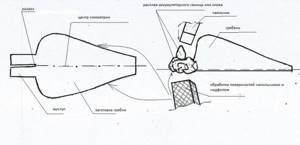
How to use
The Ulyanka spinner is a spinner measuring just over 6 cm and weighing up to 10 grams, designed for single-ton bottom fishing. The main type of fishing with this spinner is slow. When moving evenly, the bait creates two types of vibrations: high-frequency, caused by vibration of the plate, and low-frequency, caused by body movements from side to side.
To allow the spinner to move in the water column or closer to the bottom, a slow retrieve is performed with the tip of the spinning rod lowered. During the retrieve, it is possible to revive the game in the form of wrist movements with the rod, during which the spoon scurries from side to side. The spoon showed itself well both when casting and when fishing using the twitching method. Trolling fishermen said that the spoon catches well at various depths. As practice shows, when trolling it is best to attach the bait to the top hole, when casting - to the middle hole.

When trolling, the fish is caught on its own, except when it attacks from behind. When fishing, the cord must be constantly tensioned; the predator's throws are dampened by the elasticity of the tackle. When fishing, you must strive to ensure that the rod makes an angle of 90 degrees with the fishing line. It is necessary to avoid a situation where the rod is in a straight line with the line. This may cause the cord to break. The spoon is effective when catching predators at any depth and in different conditions. With its skillful use, the chances of catching trophy fish increase significantly, especially in large bodies of water.
Design
The design of the spinner is such that one spinner can show a very diverse game : when stopped, the spinner sinks to the bottom with the petal swaying and moving horizontally; when pulled, it creates an oscillation of the petal of different frequencies with the petal tapping on the comb.
The closer the fishing line is tied to the back of the spoon, the stronger the frequency oscillations of the petal and the tapping on the comb, and the stronger the resistance of the spoon.
For trolling, the spoon is tied closer to the head ; when casting, you should be creative with the wiring, using different wiring and different holes for tying the fishing line.
For pike perch, stepwise wiring is suitable ; for pike and perch, it is selected experimentally. Often works on pauses when lowering to the bottom.
Options
For surface wiring, the hive is small and not heavy (weight 4-7 g, length 3-5 cm) without moving the head-load beyond the petal. The hook is single, directed upward when inserted.
To overcome green obstacles, you just need to lift the tip of the rod up and speed up - the spoon quickly comes to the surface and jumps over the algae without getting caught by the hook. Good for catching perch and pike hunting in thickets.
For fishing at all levels of water, a hook with a heavy head is designed.
A quick pull, lifting the tip of the rod up - lifting the spoon from the depths to the surface.
To deepen to any horizon, a pause is made, during which the hive is lowered to the required depth and pulled at a certain speed (3-5 km/h).
The spoon catches all types of predatory fish , but is most catchy for pike, pike perch, large perch, asp, and catfish.
Tricks of fishing with "Ulyanka"
The invention of S. Ulyanov is among the universal spinners that can be used to successfully catch all freshwater predators: pike perch, pike, perch. By testing “Ulyanka” for several months, you can be convinced of its effectiveness.
One of the properties of the spoon is its ability to move away from the fisherman when the fishing line is weakened, pulling on the cord. Therefore, when performing a series of pulls with slowdowns, created without reeling, the cord is tightened due to the wagging of the bait from side to side or when lowered to the bottom. With such movements, it becomes possible to leave the bait on a promising area, without tipping it to the bottom.
In addition, while moving the bait near the surface, it is possible to slow down, during which it sinks to the bottom, creating characteristic vibrations. In this case, it is worth taking long pauses, because the bait, especially with a taut cord, moves very slowly.
To additionally attract a predator, it is possible to bring the spoon to the surface of the water. The speed of the wiring should be approximately the same as when wiring near the surface. At the same time, uniform movement of the bait on a plane attracts fish least of all.
This is due to the fact that during an equally dependent stroke along the plane, after its nasal lobe is above the plane, the sweeping frequency is replaced by fluttering oscillations. Therefore, to create vibrations in calm, windless weather, to create constant disturbances, it is advisable to alternate short sections of bait fishing under the water plane with constant transitions to the surface.
If you are using a spinner as a non-hooking bait, you should choose “windows” in the vegetation where you should throw the bait. Retrieving begins immediately after casting, preventing the bait from sinking to the bottom. In this case, the spoon should be brought to the surface, avoiding its immersion in the thickness of the vegetation.
Making a spinner body from brass and copper
If you have small pieces of brass or copper at your disposal, then you can make very catchy baits from them.
To get bait for catching a predator, you should follow the following tips:
- To begin with, you should make blanks that resemble the shape of a small fish, for example, bleak. The shape may resemble a rhombus or an oval.
- On the side of the thinner area of the bait's body, a hole is drilled to attach the spinner to the fishing line.
- Next, you should give the body of the spinner a slight bend.
- On the opposite side of the body of the spoon, where the hook is attached, the spoon is covered with a layer of solder. This will make it possible to make the bait heavier.
- Finally, the bait is sanded and polished. The spoon is ready for use.
Bimetallic spoon
A bimetallic spinner is a bait made of two metals. As a rule, copper and aluminum are used, although they will not last long together.
To make such a bait, you need to prepare two plates of copper and aluminum that are identical in size and shape. To connect two workpieces, two holes are drilled in them. Moreover, it is necessary to drill in two plates at once, clamped in a vice. After this, they are connected using rivets. Finally, using the stamping method, the bait is given the appropriate shape. For greater attractiveness, the body of the spinner is sanded with fine sandpaper and polished. The bait must be coated with a transparent water-repellent varnish, otherwise over time it will lose its attractive appearance.
Tubular spoon
A tubular spoon is made from a piece of pipe of small diameter. Typically, this is a pipe made of metal such as steel, stainless steel, copper, brass, aluminum, etc.
How it's done:
- A piece of pipe is taken and cut so that 2 sharp angles are formed along the edges, different in size.
- The edges of the cuts are processed with a file and sandpaper.
- A hole is drilled on both sides of the spoon's body.
- All that remains is to attach the tee to the bait, installing winding rings at both ends.
When installing a tee, you should pay attention to the size of the acute angle. Where it is smaller (that is, where the angle is blunter), the tee is attached to that side. The main line is attached to the sharper corner. Only in this way will the bait, during the wiring process, resemble the movements of a fish in the water column.
Tubular compound spoon
This version of the spinner is an improvement on the previous version. It consists of three parts, independent from each other, capable of performing intricate movements in the water. The individual parts are connected using winding rings. The movements in the water of this spoon are much more attractive to a predator, compared to a regular tubular spoon.
Corrugated spoon
The bait is made using the same technology as a regular tubular spoon. The only difference is that a corrugated pipe is used for manufacturing. In order not to bother, you can buy a piece of pipe in a store. It is not expensive, but from 1 meter of thin pipe you can make several baits that are quite cheap, but very catchy.
Due to the fact that the pipe is corrugated, as it moves through the water column it emits acoustic vibrations that can interest a predator.
What is Matveychikov's spinner
Visually, and from a design point of view, Matveychikov’s bait for winter fishing for perch does not look complicated. More often, the winter spinner flumen by Vladimir Matveychikov is made of brass - nickel or copper, and can also be coated with silver. Its length is 40 mm, weight 2.5 grams. A hook is attached to it - a tee. The brand of hook depends on the manufacturer.
Appearance
Among all the baits, Matveychikov’s winter tackle triggers the hunting instinct of a perch that is in an inhibited state. Visually, it looks like a small fish, which when played, especially up from the bottom, creates the complete impression of fleeing prey.
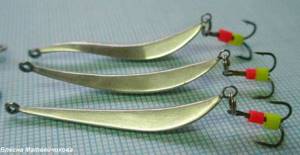
What kind of fish can be caught with this bait?
Repeated testing of this gear in winter allowed us to make an unambiguous conclusion that any predatory fish can become prey. However, the very fact that Vladimir Matveychikov created this bait for “sports” perch fishing speaks of the “target audience” among fish. The test of time has shown that perch can be caught with this bait.
Blank drawing
To make a bait, you need a drawing, which is best done on a sheet of special graph paper. This simplifies the work of subsequent adjustment of the workpiece to the required dimensions.

Do-it-yourself winter lure for perch: drawings
Where to get material for a spinner
Most often, Matveychikov’s homemade winter spinner is made from cupronickel or copper. You can purchase any of these materials both in city markets and online. A good option would be to find like-minded people on a specialized forum and buy the material together. Tin is also sold in stores and markets. Using it, we take, for example, any piece of brass and glue it tightly.
If lead is needed, it can be obtained from an old battery. The only thing is that you must follow safety rules, since the battery contains acid and alkali.
Alternatives to Matveychikov bait
Winter flumen of Vladimir Matveychikov is not a monopolist on perch fishing. There are many varieties. The classic diamond is a spinner that every Soviet person has seen or had in their set. It is made of brass. This winter tackle is designed for catching perch at a depth of up to 5 meters in lakes. Its effectiveness is debatable, but probably every second person has tried fishing with it.
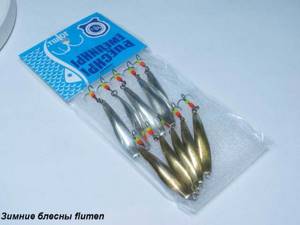
St. Petersburg sleeper is a winter bait made of copper and brass. Indeed, it resembles a sleeper or a Twix stick. Used for catching perch under ice, in running water. Spinner is a tube for winter fishing. A piece of brass pipe with a diameter of 5 mm, where one end is beveled at an angle of 45 degrees, so that it moves unevenly, but with turbulence, unwinding from the flow.
A treble hook can be attached. Well suited for fast currents and for fishing to a depth of one or two centimeters of water, where perch and pike species take it well.
Making an oscillating spoon
Making your own oscillating bait is not difficult. You just need to decide on the available materials. After all, in principle, the creation of gear has the goal of saving on the purchase of new products, thanks to its production from scrap materials.
From the rest of the teaspoon (without handle)

From one spoon you can make two wonderful models that can effectively prove themselves in a game with a predator.
Step-by-step instructions for making a spinner:
- The workpiece is carefully filed at the cut site using a needle file.
- A hole is created at each edge. Ready!
To ensure effective play of the bait, it is recommended to connect the spoon to the tee using a ring a couple of times larger than its hook “comrade”, as in the previous version of the homemade product.
From the handle of a steel or cupronickel silver tablespoon
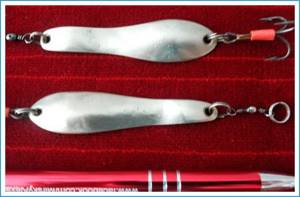
With the help of a tablespoon, you can make a homemade product with almost perfect body symmetry. It is perfect for wiring in the thickness of the aquatic environment.
Step-by-step instructions for making gear:
- To begin with, it is recommended to saw off the spoon from the handle and carefully file the edge. But before that, it should be reduced in length by two centimeters.
- Create two holes in the blank and rig the bait.
- In this case, it is very important not to neglect the dimensions and quality of the equipment used. That is why the ring connecting the bait and the tee is recommended to be selected a couple of times larger than its hook counterpart.
- The tee is mounted on the wide tip of the handle.
- To make the bait more catchable and effective, polyethylene strips of different colors are additionally attached to the tip of the tee. Disposable bags can be used as starting material.
- The equipment is ready!
Homemade Devon tackle
Since its birth, the Devon spinner has gained popularity among fishing enthusiasts. You can do it yourself in your own garage. The bait is powered by a turbine assembled from scrap materials. To assemble the device you will need:
- Beer can for making an aluminum turntable.
- Wire frame.
- Lead pellets.
- Carnation.
Apply the outline of a small propeller to the can, bend the workpiece in the form of a screw, and punch a hole in the middle of the part with a nail. Make a frame out of wire, tie a small tee hook on one end, and string pellets on the other. Tie a knot in the wire, then attach the propeller. The prepared structure can be painted in the desired color.
An analogue of the Devon spinner is made from the handle of an aluminum spoon.

This exclusive model is created similar to the one indicated above (for a steel or nickel silver handle). It is perfect for asp fishing.
There is only a slight difference here: the tee is mounted on the thin side of the workpiece. This will prevent the bait from jumping out from the thickness of the reservoir during the posting process. Plus, the additional use of polyethylene pieces on the tee is not necessary.
Ultralight microvibrators
Such baits are created identically to their bimetallic counterpart. The only difference is that special attention is paid to the processing process at the final stage. The edges of the homemade product are rounded with a file, and its outer surface is practically reduced to nothing at the end. Then everything is further polished and polished. And only now the vibrator can be called ready!
Homemade fishing spinner
You can easily make this fishing tackle from an ordinary tablespoon. An economical option, made according to all the rules, will not be inferior to the purchased spinner bait, the drawings for the manufacture of which are made by hand according to individual sizes. This is a catch device of simple design. To complete the gear, you will need to purchase several parts manufactured in industrial conditions.
To make the device, you can use not only cutlery; an aluminum tube, a spoon handle made of cupronickel or stainless metal will do. The popularity of the tackle is due to the fact that the workpiece can be found in any home. The main condition for choosing a material is the absence of traces of oxidation and rust upon contact with water. Otherwise, the lure will have to be polished each time before use.
When planning to make bait at home, you should take into account that it is not always possible to get a high-quality noise lure from a spoon. In this case, preference should be given to a workpiece made of an aluminum tube, into the cavity of which it is recommended to add shot. When trolling, tube gear produces noise and vibration, attracting the attention of fish.
An ordinary tablespoon is suitable for the production of not only “Spinners”; the blank will make a micro-spinner for perch. When manufacturing the device, you will need a set of consumables:
- Spoon.
- Thin strong wire.
- Rings for hooks and braids.
- Double or tee hooks.
- Swivels.
Spinner spinners and micro-oscillators are catch-type spinners. Universal tackle attracts fish of different breeds, depending on the size of the main part; rudd or catfish will pay attention to the fishing rod. According to the characteristics, a spinner can be: front-loaded, back-loaded, with an Aglia or comet-type petal shape, as well as with tubes, beads or pellets.
Rotating spoon and its types
Rotating baits are the most common spinning equipment. In common people you can hear such a name as “turntables”. It is the same.
The main advantage of such a spinner is that for a high-quality game you do not need any special skills from the fisherman. Although it is primitive at first glance, it is very effective for fishing. Very often such elements are recommended for beginners. After all, everyone wants to catch a good catch, even those who came to fish for the first time.
Spoons with turbines
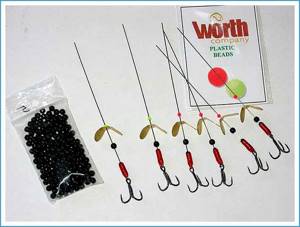
First of all, it is worth noting that this bait is perfect for ultralight. It can be purchased at any specialized store, or you can make it yourself.
Stages of creating a spinner with turbines:
1. First, we will start making the petal. To do this, we need metal, for example, from a car telescopic antenna or another sheet no more than one millimeter thick. 1.1 Draw a small template on cardboard and cut it out. It is from this blank that we will make a sketch on a metal sheet. 1.2 After we have the workpiece, all edges are carefully processed with a needle file. 1.3 We make holes at both ends of the homemade product and remove any burrs that appear. 1.4 We bend the sides with holes to the petal area. The petal is ready! 2. Glue a tee to a stainless steel wire with a diameter of no more than 1.5 mm. 3. Then we wind the bead and the petal itself. 4. We make a slight bend in the subsequent loop to fix the monofilament at the required distance from the top of the petal. Moreover, in this case it is necessary to eliminate the obstruction to the rotation of the load of the tackle itself. 5. Only then can you begin to secure the load on the twist of the loop itself. Due to the asymmetry of the load, the monofilament thread will not twist. 6. After slightly bending the wings to match the shape of the propeller, the bait is completely ready for new achievements. This tackle is perfect for catching perch, pike perch and chub. If its dimensions are slightly increased, you can even catch a trophy specimen of pike.
Petal spinner
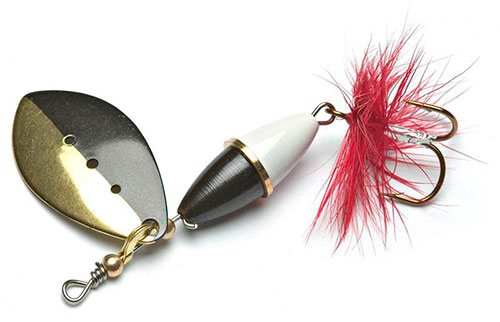
The petal is the most attractive part of the bait, since the speed and nature of vibration of the entire equipment will depend on its design and shape. Moreover, the predator will examine and evaluate such tackle from a very impressive distance. Rotation of the petal at a large angle will cause the strongest vibration, while with a decrease in this parameter, the activity of the bait will decline.
Having caught 237 kg of fish, the poachers were not punished!
During interrogation, the detained fishermen revealed the name of the secret bait. Read more…
The shape of the petal of the tackle is also of great importance. There is an unwritten rule: the narrower the part, the stronger the speed of its rotation. Accordingly, the game is more active.
Tips from fishermen regarding the use of individual models:
- if you plan to fish at great depths or in a body of water with a strong current, it is best to give preference to a model with thin narrow petals;
- whereas in shallow water and in standing water, specimens with wide, spreading leaves are perfect.
But there are also negative sides to using this type of equipment. This is primarily the sticking of the bait petals. Because this minimizes all the efforts of the fisherman to catch fish. The ease and speed of winding the tackle leads to its slow wiring. Only in this case is it possible, without disrupting the rotation of the petals, to change the height of the spinner itself.
There are also models that additionally have a front sight on the tee. The latter can serve as another irritant for the predator, and can influence the stabilization of the equipment during the wiring process. For the most part, it is a fly or a small tuft of red fur.
For which fish is the Ulyanka spinner used?
Most fishermen agree that this is a universal bait for predators. It is perfect for perch, pike, pike perch and many other species. But it is worth noting that its wiring, although simple at first glance, still requires great perseverance and perseverance. This is the case if you decide to definitely acquire a catch.
Although there is a small plus: it can be used in any weather. A creative approach and ingenuity are a guarantee of successful fishing.
Where, how and what to catch on “Ulyanka”
In the few years that have passed since the invention of Sergei Ulyanov’s signature bait, fishermen have managed to explore the possibilities of the new product. It turned out that Sergei’s original bait catches all freshwater predators.
If you equip your spinning rod with an Ulyanka spinner, your trophy may include:
- pike;
- zander;
- perch.
The spoon showed itself well both when casting and when using the trolling method. Trolling fishermen said that the Ulyanka fished well at a variety of depths. One of the amateur fishermen boasted that he caught a pike with it at a depth of 18 meters. Practice has shown that if you catch a predator by casting, then it is better to attach the “Ulyanka” to the middle hole on the ridge, and when trolling, to the front hole. It is useful to vary the pace of retrieving the bait. You can use jig methods for baiting.
The invention of Sergei Ulyanov is a universal bait. You can catch all freshwater predators with it. This lure can be used for both trolling and casting.
How to increase your fish catch?
Over 7 years of active fishing, I have found dozens of ways to improve the bite. Here are the most effective ones:
- Bite activator . This pheromone additive attracts fish most strongly in cold and warm water. Discussion of the bite activator “Hungry Fish”.
- Increased gear sensitivity. Read the appropriate manuals for your specific type of gear.
- Pheromone -based lures .
